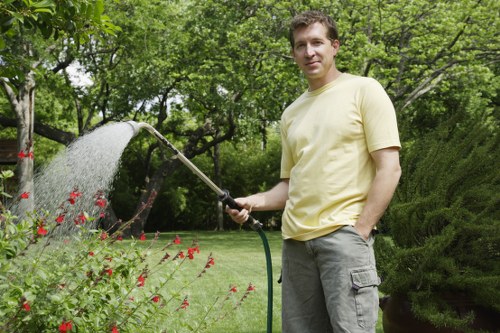Effective Driveway Algae Removal in Teddington

Algae growth on driveways is a common issue faced by many homeowners in Teddington. Not only does it affect the appearance of your property, but it can also lead to slippery surfaces, posing safety hazards.
Understanding the causes of algae growth is the first step towards effective removal. Typically, algae thrive in damp and shaded areas, making driveways in these regions particularly susceptible.
Regular maintenance and timely intervention can prevent extensive algae buildup, saving you time and money in the long run.
Understanding Driveway Algae: Causes and Effects

Algae are simple plants that thrive in moist environments. On driveways, they often appear as green, slimy patches that can quickly spread if left untreated.
The primary causes of algae growth include excessive moisture, lack of sunlight, and the presence of organic materials that provide nutrients for algae to flourish.
Besides the aesthetic impact, algae can make driveways slippery, increasing the risk of accidents. Over time, the growth can also damage the driveway surface, leading to costly repairs.
Identifying Algae on Your Driveway: Signs to Look For

Early detection of algae can significantly ease the removal process. Look for green or black patches that appear slimy or slippery when wet.
Algae can often be found in areas that receive limited sunlight, such as shaded parts of the driveway or areas near trees and shrubs.
Regular inspections, especially after rain, can help in spotting algae growth before it becomes a major problem.
Benefits of Professional Algae Removal Services

Hiring professionals for algae removal ensures that the job is done efficiently and effectively. Experts have access to specialized equipment and eco-friendly solutions that are safe for your driveway and the environment.
Professional services also offer long-term preventive measures, reducing the likelihood of future algae growth.
Additionally, they can provide personalized advice tailored to the specific needs of your driveway and the local climate conditions in Teddington.
Methods for Removing Algae from Driveways
Chemical Treatments
Chemical cleaners are often used to kill and remove algae. These solutions are effective but should be applied carefully to avoid damage to surrounding vegetation.
It's essential to choose the right type of chemical treatment based on the severity of the algae growth and the material of your driveway.
Pressure Washing
Pressure washing is a popular method for removing algae due to its effectiveness in blasting away the growth without the use of chemicals.
This method is suitable for most driveway materials, including concrete, brick, and asphalt.
Eco-Friendly Solutions
For those concerned about the environment, there are eco-friendly algae removal options available. These include natural cleaners made from vinegar, baking soda, and other non-toxic substances.
Eco-friendly methods are safe for pets, children, and surrounding plant life, making them a preferred choice for many homeowners.

Regular maintenance, such as sweeping and sealing your driveway, can also prevent algae growth by reducing moisture and shielding the surface from harmful elements.
Implementing preventive measures not only keeps your driveway algae-free but also enhances its longevity and curb appeal.
Preventing Algae Growth on Your Driveway
Prevention is always better than cure. To prevent algae from taking hold on your driveway, consider the following tips:
- Ensure proper drainage: Poor drainage can lead to water pooling, creating an ideal environment for algae.
- Trim surrounding vegetation: Reducing shade by trimming trees and shrubs allows more sunlight to reach the driveway.
- Regular cleaning: Keeping the driveway clean from debris reduces the organic matter that algae feed on.
- Seal your driveway: Applying a sealant can protect the surface from moisture and prevent algae growth.
Choosing the Right Algae Removal Service in Teddington
When selecting an algae removal service, consider the following factors:
- Experience and reputation: Look for companies with a proven track record in algae removal.
- Eco-friendly options: If environmental impact is a concern, choose services that offer green solutions.
- Customer reviews: Reading testimonials can provide insights into the quality of service.
- Pricing: Compare quotes to ensure you're getting value for money.
Common Myths About Driveway Algae Removal
There are several misconceptions about algae removal. Debunking these myths can help homeowners make informed decisions:
- Myth: Algae is only a cosmetic issue.
- Fact: Algae can make driveways slippery and potentially cause accidents.
- Myth: DIY methods are always effective.
- Fact: While some DIY methods work, professional services often provide more thorough and long-lasting results.
- Myth: Algae removal is a one-time task.
- Fact: Regular maintenance is necessary to keep algae from returning.
Local Expertise: Why Teddington's Neighborhoods Need Custom Solutions
Teddington comprises several distinct areas, each with unique characteristics that influence algae growth and removal strategies. Understanding these local nuances ensures effective treatment tailored to each neighborhood.
- East Teddington: Known for its lush gardens, East Teddington requires algae removal services that protect surrounding vegetation.
- West Teddington: With many paved pathways, preventing algae in high-traffic areas is crucial.
- South Teddington: Proximity to the River Thames means dealing with higher humidity levels, necessitating robust preventive measures.
- North Teddington: The mix of residential and commercial properties here demands flexible algae removal solutions.
- Kew: Close to botanical gardens, eco-friendly algae removal is highly preferred.
- Richmond: High property values mean homeowners seek premium algae removal services.
- Twickenham: Combining sports facilities with residential areas requires quick and effective algae treatments.
- Hampton Wick: Maintaining aesthetics is key, so discreet and non-invasive removal methods are favored.
- Sunbury-on-Thames: A focus on community spaces means communal driveways need specialized care.
- Brentford: Urban settings with limited green spaces require targeted algae management strategies.
- Shepperton: The mix of old and new properties calls for versatile algae removal techniques.
- Chiswick: Busy commercial areas need efficient algae removal to minimize disruption.
- Hounslow: Diverse architectural styles benefit from customized algae treatment plans.
- Fulham: High-rise residential buildings require scalable algae removal solutions.
- Streatham: Community-driven initiatives support neighborhood-wide algae prevention programs.
Conclusion
Driveway algae can be a persistent problem, but with the right knowledge and professional assistance, it can be effectively managed. By understanding the causes, identifying early signs, and implementing preventive measures, homeowners in Teddington can maintain clean and safe driveways. Investing in professional algae removal services not only enhances the aesthetic appeal of your property but also ensures long-term durability and safety.
Frequently Asked Questions
1. How long does algae removal take?
The duration of algae removal depends on the extent of the growth and the method used. Typically, professional treatments can be completed within a few hours.
2. Is algae removal safe for my driveway surface?
Yes, when done by professionals using appropriate methods, algae removal is safe and does not damage the driveway surface.
3. Can I prevent algae from returning?
Yes, implementing preventive measures such as ensuring proper drainage, reducing shade, and regular cleaning can significantly reduce the chances of algae returning.
4. Are eco-friendly algae removal methods effective?
Absolutely. Eco-friendly methods are not only effective but also safer for the environment, pets, and plants compared to chemical treatments.
5. How often should I have my driveway treated for algae?
It's recommended to have your driveway inspected and treated at least once a year, especially in areas prone to moisture and shade.


